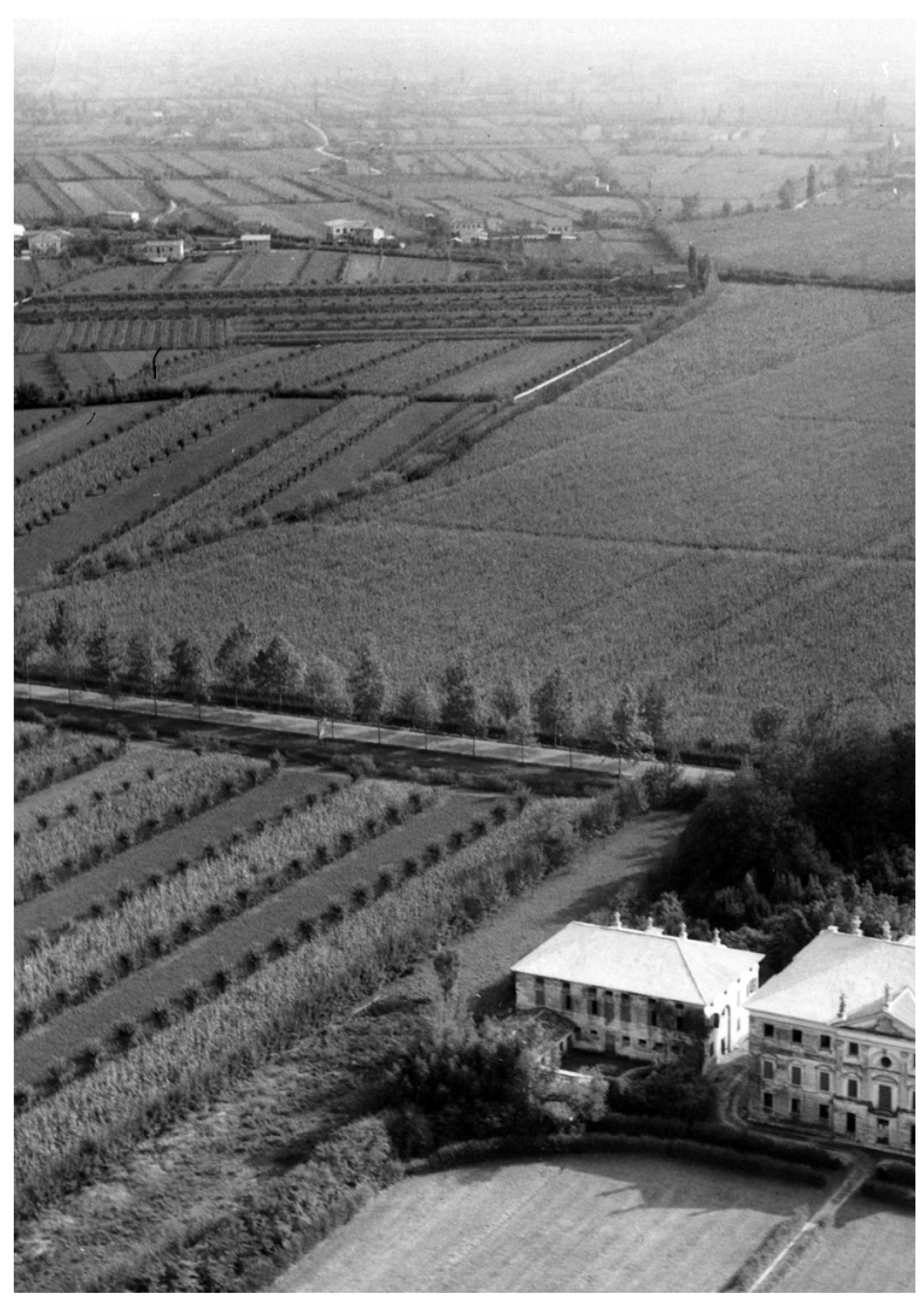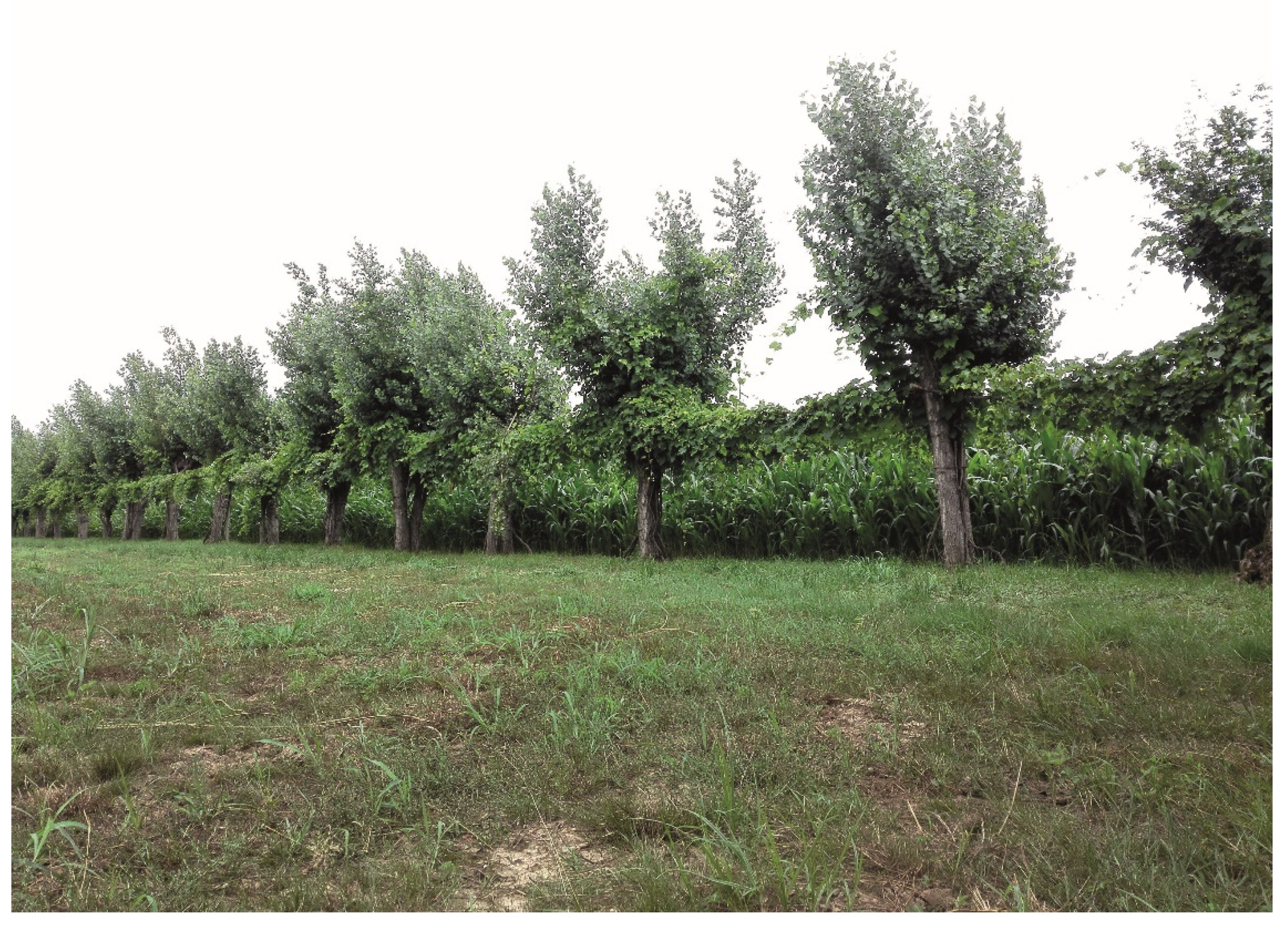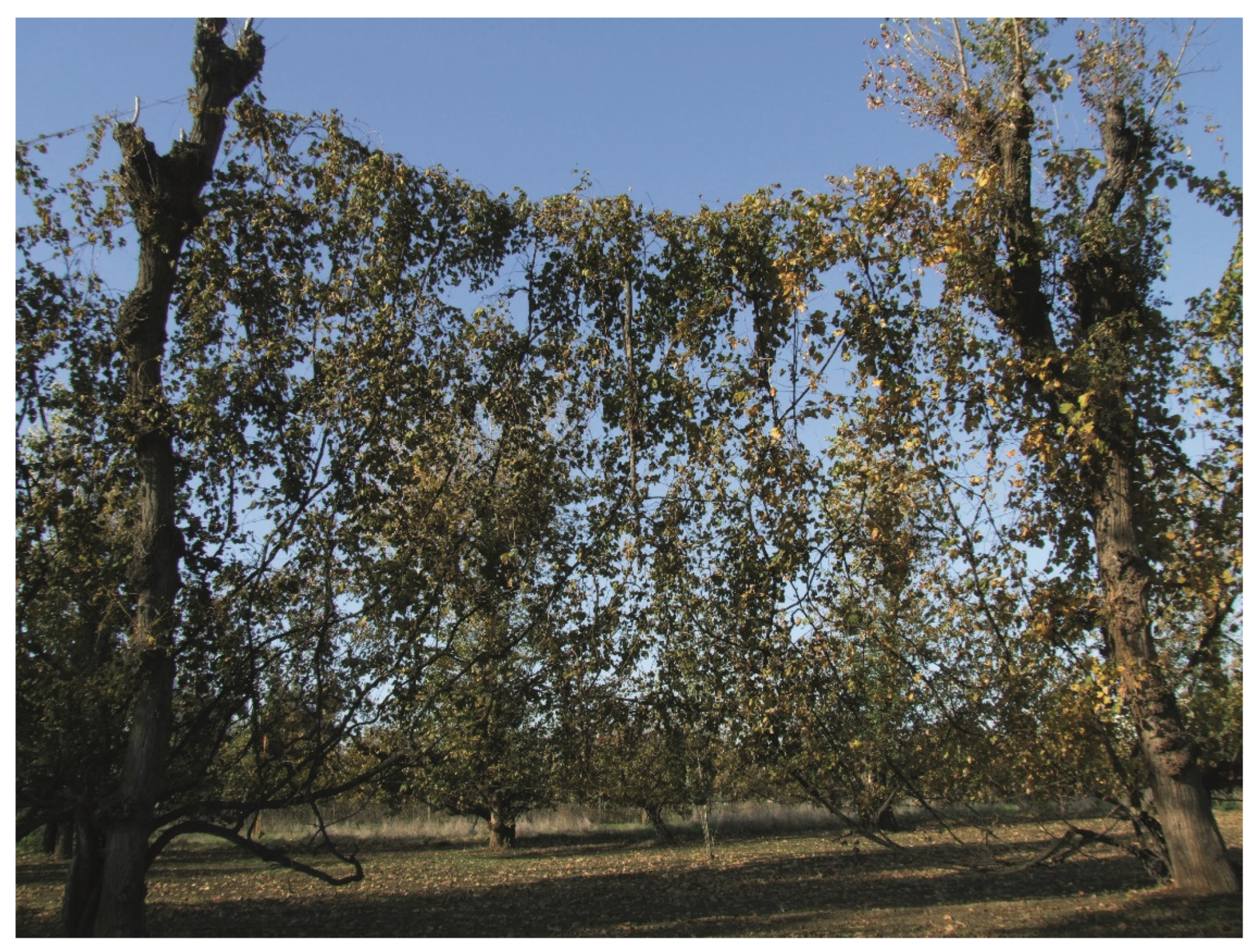Learning from Agricultural Heritage? Lessons of Sustainability from Italian “Coltura Promiscua”
Abstract
:1. Introduction
2. Materials and Methods
3. Results
3.1. What Is the Italian “Coltura Promiscua”?
We have a large number of crops and widely ranging cultivation methods. The most diverse crops follow one another in the same field, within the same year. Herbaceous plants are promiscuously grown and mixed with arboreal plants. Where there are olive trees, grape vines, mulberries, and other fruit trees, there is no lack of cereals, legumes, and other industrial or fodder plants. We are miles apart from agriculture practiced in a number of European countries, where crops do not compete for the same land, and plantations does not follow one another, alternating regularly, over significantly extensive areas [53] (page 132. My translation).
3.2. The Rise and Fall of Coltura Promiscua: Discussing “Rationality”
Think and rethink, is it not best to have/long rows in wide fields, /vines will profit of the field’s tillage, /and the sun’s hot rays will reach them. /
Obtaining a harvest of grains and wine at the same time from the same field is something that can only be had in a climate as hot as that of Italy (...) Unfortunately, one encounters large tracts of country where the pollards serve as tutors to the vines, with serious prejudice to agriculture, with fields transmuted in this way into forests (...) To such unthinking people, the quality of the wine matters little; they pay attention only to the species that produce a lot and that react better to atmospheric events [38] passim (my translation, from the Italian translation published in 1843).
3.3. An Incomplete Fall: Relics of Coltura Promiscua and the Reasons Why They Are Preserved
- Supplementary income or supply, like fruit, grapefruit, wine, timber (economic value);
- Expressing a personal ability; satisfaction for a well-done job; practicing an open-air activity (functional value);
- Emotional bond, for example, memory of the family; a way to meet the family and friends, for example during grape harvest (social value);
- The will to transmit an ancient know-how to the following generation (cultural value).
- The great amount of time spent taking care of coltura promiscua.
- There is little or no recognition by local or regional institutions.
3.4. Heritagisation of Coltura Promiscua
4. Discussion: Learning from Coltura Promiscua
Who Is Learning What from Coltura Promiscua?
5. Conclusions
Funding
Informed Consent Statement
Acknowledgments
Conflicts of Interest
References
- Vos, W.; Meekes, H. Trends in European Cultural Landscape Development: Perspectives for a Sustainable Future. Landsc. Urban Plan. 1999, 46, 3–14. [Google Scholar] [CrossRef]
- Threatened Landscapes; Green, B.; Vos, W. (Eds.) Spon Press-Taylor & Francis: London, UK; New York, NY, USA, 2003; ISBN 9781135802578. [Google Scholar]
- The New Dimensions of the European Landscape; Wageningen UR frontis series; Jongman, R.H.G. (Ed.) Springer: Dordrecht, The Netherlands; Norwell, MA, USA, 2004; ISBN 9781402029097. [Google Scholar]
- Antrop, M. The Concept of Traditional Landscapes as a Base for Landscape Evaluation and Planning. The Example of Flanders Region. Landsc. Urban Plan. 1997, 38, 105–117. [Google Scholar] [CrossRef]
- Pinto Correia, T.; Vos, W. Multifunctionality in Mediterranean landscapes. Past and future. In The New Dimensions of the European Landscape; Wageningen UR frontis series; Jongman, R.H.G., Ed.; Springer: Dordrecht, The Netherlands; Norwell, MA, USA, 2004; pp. 135–164. [Google Scholar]
- Italian Historical Rural Landscapes. Cultural Values for the Environment and Rural Development; Agnoletti, M., Ed.; Springer: Dordrecht, The Netherlands; Norwell, MA, USA, 2013. [Google Scholar]
- Renes, H.; Centeri, C.; Kruse, A.; Kučera, Z. The Future of Traditional Landscapes: Discussions and Visions. Land 2019, 8, 98. [Google Scholar] [CrossRef] [Green Version]
- Purvis, B.; Mao, Y.; Robinson, D. Three pillars of sustainability: In search of conceptual origins. Sustain. Sci. 2019, 14, 681–695. [Google Scholar] [CrossRef] [Green Version]
- OECD. Multifunctionality: Towards an Analytical Framework; OECD: Paris, France, 2001. [Google Scholar]
- Van Huylenbroeck, G.; Vandermeulen, V.; Mettepenningen, E.; Verspecht, A. Multifunctionality of Agriculture: A Review of Definitions, Evidence and Instruments. Living Rev. Landsc. Res. 2007, 1, 5–43. [Google Scholar] [CrossRef]
- Altieri, M.A. Agroecology: The science of natural resource management for poor farmers in marginal environments. Agric. Ecosyst. Environ. 2002, 93, 1–24. [Google Scholar] [CrossRef]
- Kassam, A.; Friedrich, T.; Derpsch, R. Global spread of Conservation Agriculture. Int. J. Environ. Stud. 2019, 76, 29–51. [Google Scholar] [CrossRef]
- Garnett, T.; Appleby, M.C.; Balmford, A.; Bateman, I.J.; Benton, T.G.; Bloomer, P.; Burlingame, B.; Dawkins, M.; Dolan, L.; Fraser, D.; et al. Sustainable Intensification in Agriculture: Premises and Policies. Science 2013, 341, 33–34. [Google Scholar] [CrossRef]
- Tilman, D.; Cassman, K.G.; Matson, P.A.; Naylor, R.; Polasky, S. Agricultural sustainability and intensive production practices. Nature 2002, 418, 671–677. [Google Scholar] [CrossRef] [PubMed]
- Lipper, L.; Zilberman, D. A short history of the evolution of the climate smart agriculture approach and its links to climate change and sustainable agriculture debates. Nat. Resour. Manag. Policy 2018, 52, 13–30. [Google Scholar] [CrossRef] [Green Version]
- Sustainable Food and Agriculture. Available online: www.fao.org/policy-support/policy-themes/sustainable-food-agriculture/en/ (accessed on 7 July 2021).
- Promote Environmentally Sustainable Agriculture. Available online: www.worldbank.org/en/topic/agriculture/brief/promote-environmentally-sustainable-agriculture (accessed on 7 July 2021).
- Sustainable Agriculture in the EU. Available online: ec.europa.eu/info/food-farming-fisheries/sustainability (accessed on 7 July 2021).
- Koohafkan, P.; Altieri, M.A. Forgotten Agricultural Heritage: Reconnecting Food System and Sustainable Development; Routledge: London, UK; New York, NY, USA, 2017. [Google Scholar]
- Brown, J.; Kothari, A. Traditional Agricultural Landscapes and Community Conserved Areas: An Overview. Manag. Environ. Qual. 2011, 22, 139–153. [Google Scholar] [CrossRef]
- Marsden, T.; Murdoch, J. Introduction between the local and the global. Confronting complexity in the contemporary food sector. In Between the Local and the Global: Confronting Complexity in the Contemporary Agri-Food Sector; Marsden, T., Murdoch, J., Eds.; Emerald Group Publishing Limited: Bingley, UK, 2006; pp. 1–8. [Google Scholar] [CrossRef]
- Wilson, G.A. From Productivism to Post-Productivism... and Back Again? Exploring the (Un)Changed Natural and Mental Landscapes of European Agriculture. Trans. Inst. Br. Geog. 2001, 26, 77–102. [Google Scholar] [CrossRef]
- Zimmermann, R.C. Recording Rural Landscapes and Their Cultural Associations: Some Initial Results and Impressions. Environ. Sci. Policy 2006, 9, 360–369. [Google Scholar] [CrossRef]
- Guttmann-Bond, E. Sustainability out of the Past: How Archaeology Can Save the Planet. World Archaeol. 2010, 42, 355–366. [Google Scholar] [CrossRef]
- Stuiver, M. Highlighting the Retro Side of Innovation and Its Potential for Regime Change in Agriculture. Res. Rural. Sociol. Dev. 2006, 12, 147–173. [Google Scholar] [CrossRef]
- Zagata, L.; Sutherland, L.; Hrabák, J.; Lostak, M. Mobilising the Past: Towards a Conceptualisation of Retro-Innovation. Sociol. Rural. 2020, 60, 639–660. [Google Scholar] [CrossRef]
- Koohafkan, P.; Altieri, M.A. Globally Important Agricultural Heritage Systems. A Legacy for the Future; Food and Agriculture Organization of the United Nations: Rome, Italy, 2011. [Google Scholar]
- Hartel, T.; Plieninger, T. European Wood-pastures in Transition. A Social-Ecological Approach; Routledge: Abingdon, UK, 2014. [Google Scholar]
- Joffre, R.; Rambal, S.; Ratte, J. The dehesa system of southern Spain and Portugal as a natural ecosystem mimic. J. Agrofor. 1999, 45, 57–79. [Google Scholar] [CrossRef]
- Herzog, F. Streuobst: A traditional agroforestry system as a model for agroforestry development in temperate Europe. Agrofor. Syst. 1998, 42, 61–80. [Google Scholar] [CrossRef]
- Plieninger, T.; Levers, C.; Mantel, M.; Costa, A.; Schaich, H.; Kuemmerle, T. Patterns and Drivers of Scattered Tree Loss in Agricultural Landscapes: Orchard Meadows in Germany (1968–2009). PLoS ONE 2015, 10, e0126178. [Google Scholar] [CrossRef]
- Cevasco, R. Environmental heritage of a past cultural landscape. Alder woods in the upper Aveto valley of the North-western Apennines. In Nature and History in Modern Italy; Armiero, M., Hall, M., Eds.; Ohio University Press: Athens, Greece, 2010; pp. 126–140. [Google Scholar]
- Singh, R.; Singh, G.S. Traditional Agriculture: A Climate-Smart Approach for Sustainable Food Production. Energ. Ecol. Environ. 2017, 2, 296–316. [Google Scholar] [CrossRef]
- Gallo, A. Le Vinti Giornate Dell’agricoltura et de Piaceri Della Villa; Appresso Gratioso Percaccino: Venezia, Italy, 1569. [Google Scholar]
- Soderini, G.V. Trattato Della Coltivazione Delle Viti e del Frutto che se ne Può Ricavare; Filippo Giunti: Firenze, Italy, 1600. (in Italian) [Google Scholar]
- Guyot, J. Culture de la Vigne et Vinification; Librairie agricole de la Maison Rustique: Paris, France, 1861. [Google Scholar]
- von Babo, A.W.F. Bericht über die im Auftrage des k.k. Ministeriums für Handel und Vokswirthschaft unternommene Bereisung der Weinbau treibenden Kronländer Oesterreichs, Kroatien, Dalmatien, Istrien, Venetien, Tirol, Krain, Steiermark; C. Gerold’s Sohn: Wien, Austria, 1866. [Google Scholar]
- Burger, J. Agricoltura del Regno Lombardo-Veneto del Consigliere Giovanni Burger. Versione Italiana del Dottor V.P. con Note del Dottor Giuseppe Moretti; Dalla Tipografia Motta ora di M. Carrara: Milano, Italy, 1843. (in Italian) [Google Scholar]
- Sereni, E. Note per una storia del paesaggio agrario Emiliano. In Le Campagne Emiliane Nell’epoca Moderna; Zangheri, R., Ed.; Feltrinelli: Milano, Italy, 1957; pp. 27–54. [Google Scholar]
- Meynier, A. Les Paysages Agraires; Colin: Paris, France, 1958. [Google Scholar]
- Desplanques, H. Il paesaggio della coltura promiscua in Italia. Rivista Geografica Italiana 1959, LXVI, 29–64. [Google Scholar]
- Sereni, E. Storia del Paesaggio Agrario Italiano; Laterza: Bari, Italy, 1961. [Google Scholar]
- Gambi, L. Critica ai concetti geografici di paesaggio umano. In Una Geografia Per la Storia; Gambi, L., Ed.; Einaudi: Torino, Italy, 1973; pp. 151–168. [Google Scholar]
- Tirone, L. Mutations récentes du vignoble italien. Méditerranée 1975, 4, 59–80. [Google Scholar] [CrossRef]
- Tirone, L. Les dynamiques récentes du vignoble italien. Méditerranée 1996, 83, 87–96. [Google Scholar] [CrossRef]
- Ferrario, V. Letture Geografiche di un Paesaggio Storico. La Coltura Promiscua Della Vite nel Veneto; Cierre: Verona, Italy, 2019. [Google Scholar]
- Ferrario, V. La coltura promiscua della vite come paesaggio rurale storico: Indagini di tipo quali-quantitivo propedeutiche alle politiche di conservazione. In Il Progetto del Territorio Nelle Fonti D’archivio; Carallo, S., Ed.; Labgeo Caraci: Roma, Italy, 2017; pp. 73–90. [Google Scholar]
- Berg, L.D. Discourse analysis. In International Encyclopedia of Human Geography, 1st ed.; Kitchin, R., Thrift, N.J., Eds.; Elsevier: Amsterdam, The Netherlands, 2009; pp. 215–221. [Google Scholar]
- Leipold, S.; Feindt, P.H.; Winkel, G.; Keller, R. Discourse Analysis of Environmental Policy Revisited: Traditions, Trends, Perspectives. J. Environ. Policy Plan. 2019, 21, 445–463. [Google Scholar] [CrossRef] [Green Version]
- National Register of Italian Historical Rural Landscapes. Candicacy “La Piantata Veneta”. Available online: www.reterurale.it/flex/cm/pages/ServeBLOB.php/L/IT/IDPagina/17429 (accessed on 31 May 2021).
- National Register of Italian Historical Rural Landscapes. Pre-candidacy “Alberata d’Asprinio”. (In Italian). Unpublished typescript.
- Ferrario, V. Dalla coltura promiscua all’agroforestazione. Imparare dai paesaggi rurali storici? In Oltre la Convenzione. Pensare, Studiare e Costruire Paesaggi Vent’anni Dopo; Puttilli, M.G., Tanca, M., Castiglioni, B., Eds.; Memorie Della Società di Studi Geografici: Firenze, Italy, 2021. [Google Scholar]
- Ministero Dell’Interno–Istituto Centrale di Statistica. Annuario statistico Italiano, Anno I; Tipografia elzeviriana: Roma, Italy, 1878. [Google Scholar]
- Stanislawski, D. Landscapes of Bacchus. The Vine in Portugal; University of Texas Press: Austin, TX, USA; London, UK, 1970. [Google Scholar]
- Altieri, M.A.; Nicholls, C.I. The simplification of traditional vineyard based agroforests in North-western Portugal: Some ecological implications. Agrofor. Syst. 2002, 56, 185–191. [Google Scholar] [CrossRef]
- Lavignac, G. Cépages du Sud-Ouest. 2000 ans d’histoire. Mémoire d’un ampélographe; Editions du Rouergue-INRA Editions: Arles, France, 2001. [Google Scholar]
- Tabak, F. The Waning of the Mediterranean 1550–1870. A Geohistorical Approach; The John Hopkins University Press: Baltimora, Italy, 2008. [Google Scholar]
- Grigg, D.B. The Agricultural Systems of the World. An Evolutionary Approach; Cambridge University Press: Cambridge, UK, 1974. [Google Scholar]
- Lebeau, R. Les Grands Types de Structures Agraires Dans le Monde. Initiations aux Études de Géographie; Masson: Paris, France, 1979. [Google Scholar]
- Meeus, J.H.A.; Wijermans, M.P.; Vroom, M.J. Agricultural Landscapes in Europe and Their Transformation. Landsc. Urban Plan. 1990, 18, 289–352. [Google Scholar] [CrossRef]
- Kruse, A.; Centeri, C.; Renes, H.; Roth, M.; Printsmann, A.; Palang, H.; Jordá, L.B.; Velarde, M.D.; Kruckenberg, H. Glossary on agricultural landscapes. J. Landsc. Ecol. 2010, 8, 99–127. [Google Scholar]
- Sereni, E. Per la storia delle più antiche tecniche e della nomenclatura della vite e del vino in Italia. In Terra Nuova e Buoi Rossi; Sereni, E., Ed.; Einaudi: Torino, Italy, 1981; pp. 101–214, (For the history of the most ancient techninques and names of vine and wine in Italy). [Google Scholar]
- Crico, L. Ecloghe Rusticali; Dalle Stampe di Giulio Trento: Treviso, Italy, 1794. [Google Scholar]
- Sereni, E. History of the Italian Agricultural Landscape. Burr Litchfield, R., Ed.; Giovanni Agnelli Foundation-Princeton University Press: Chichester, UK, 1997. [Google Scholar]
- Widgren, M. Resilience thinking versus political ecology. Understanding the dynamics of small-scale, labour-intensive farming landscapes. In Resilience and the Cultural Landscape: Understanding and Managing Change in Human-Shaped Environments; Plieninger, T., Bieling, C., Eds.; Cambridge University Press: Cambridge, UK; New York, NY, USA, 2012; pp. 95–110. [Google Scholar]
- Antrop, M. Why Landscapes of the Past Are Important for the Future. Landsc. Urban Plan. 2005, 70, 21–34. [Google Scholar] [CrossRef]
- Tsonkova, P.; Böhm, C.; Quinkenstein, A.; Freese, D. Ecological benefits provided by alley cropping systems for production of woody biomass in the temperate region: A review. Agrofor. Syst. 2012, 85, 133–152. [Google Scholar] [CrossRef]
- Dupraz, C.; Newman, S.M. Temperate Agroforestry: The European Way. In Temperate Agroforestry Systems; Gordon, A.M., Newman, S.M., Eds.; CAB International: Wallingford, UK; New York, NY, USA, 1997; pp. 181–236. [Google Scholar]
- Lehmann, L.M.; Smith, J.; Westaway, S.; Pisanelli, A.; Russo, G.; Borek, R.; Sandor, M.; Gliga, A.; Smith, L.; Ghaley, B.B. Productivity and Economic Evaluation of Agroforestry Systems for Sustainable Production of Food and Non-Food Products. Sustainability 2020, 12, 5429. [Google Scholar] [CrossRef]
- Paris, P.; Camilli, F.; Rosati, A.; Mantino, A.; Mezzalira, G.; Dalla Valle, C.; Franca, A.; Seddaiu, G.; Pisanelli, A.; Lauteri, M.; et al. What Is the Future for Agroforestry in Italy? Agrofor. Syst. 2019, 93, 2243–2256. [Google Scholar] [CrossRef] [Green Version]
- Lang, C.P.; Merkt, N.; Geilfus, C.-M.; Graeff–Hönninger, S.; Simon, J.; Rennenberg, H.; Zörb, C. Interaction between Grapevines and Trees: Effects on Water Relations, Nitrogen Nutrition, and Wine. Arch. Agron. Soil Sci. 2019, 65, 224–239. [Google Scholar] [CrossRef]




Publisher’s Note: MDPI stays neutral with regard to jurisdictional claims in published maps and institutional affiliations. |
© 2021 by the author. Licensee MDPI, Basel, Switzerland. This article is an open access article distributed under the terms and conditions of the Creative Commons Attribution (CC BY) license (https://creativecommons.org/licenses/by/4.0/).
Share and Cite
Ferrario, V. Learning from Agricultural Heritage? Lessons of Sustainability from Italian “Coltura Promiscua”. Sustainability 2021, 13, 8879. https://doi.org/10.3390/su13168879
Ferrario V. Learning from Agricultural Heritage? Lessons of Sustainability from Italian “Coltura Promiscua”. Sustainability. 2021; 13(16):8879. https://doi.org/10.3390/su13168879
Chicago/Turabian StyleFerrario, Viviana. 2021. "Learning from Agricultural Heritage? Lessons of Sustainability from Italian “Coltura Promiscua”" Sustainability 13, no. 16: 8879. https://doi.org/10.3390/su13168879
APA StyleFerrario, V. (2021). Learning from Agricultural Heritage? Lessons of Sustainability from Italian “Coltura Promiscua”. Sustainability, 13(16), 8879. https://doi.org/10.3390/su13168879





